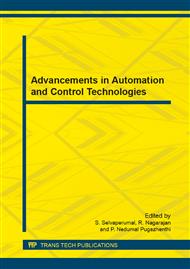[1]
J. Aggarwal and Q. Cai , Human motion analysis: A review, Comput. Vis. Image Understanding. vol. 73, p.428–440, (1999).
Google Scholar
[2]
J. E. Boyd, Synchronization of oscillations for machine perception of gaits, Comput. Vis. Image Understanding, vol. 96, no. 1, p.35–59, (2004).
DOI: 10.1016/j.cviu.2004.04.004
Google Scholar
[3]
Changhong Chen a, Jimin Liang a, Heng Zhao a, Haihong Hu a, Jie Tian , Frame difference energy image for gait recognition with incomplete silhouettes, Pattern Recognition Letters 30 (2009) 977–984.
DOI: 10.1016/j.patrec.2009.04.012
Google Scholar
[4]
Zongyi Liu, Laura Malave, and Sudeep Sarkar, Studies on Silhouette Quality and Gait Recognition , Computer Science and Engineering University of South Florida; Tampa.
DOI: 10.1109/cvpr.2004.1315233
Google Scholar
[5]
Little J.J., Boyd J.E., 1998. Recognizing people by their gait: The shape of motion.
Google Scholar
[6]
Liu, Z., Sarkar, S., Effect of silhouette quality and hard problems in gaitrecognition, IEEE Trans. Systems Man and Cybernetics (2005).
Google Scholar
[7]
Liu, J., Zheng, N., Gait History Image: A novel temporal template for gaitrecognition, IEEE Internat. Conf. on Multimedia and Expo, p.663–666, (2007).
DOI: 10.1109/icme.2007.4284737
Google Scholar
[8]
Boulgouris, N.V., Hatzinakos, D., Plataniotis, K.N., Gait recognition: A challenging signal processing technology for biometric identification, IEEE Signal Process. Mag. 22, 78–90, (2005).
DOI: 10.1109/msp.2005.1550191
Google Scholar
[9]
Liu, Z., Malave, L., Sarkar, S., Studies on silhouette quality and gait recognition, In IEEE Internat. Conf. on Computer Vision and Pattern Recognition, p.704–711, (2004).
DOI: 10.1109/cvpr.2004.1315233
Google Scholar
[10]
Han, J., Bhanu, B., Individual recognition using Gait Energy Image. IEEE Trans. Pattern Anal. Machine Intell. 28 (2), 316–322, (2006).
DOI: 10.1109/tpami.2006.38
Google Scholar
[11]
L. Wang, W. Hu, and T. Tan, A new attempt to gait-based human identification, in Proc. Int. Conf. Pattern Recognition, vol. 1, 2002, p.115–118.
Google Scholar
[12]
L. Wang, T. Tan, H. Ning, and W. Hu, Silhouette analysis-based gait recognition for human identification, IEEE Trans. Pattern Anal. Mach. Intell., vol. 25, no. 12, p.1505–1518, Dec (2003).
DOI: 10.1109/tpami.2003.1251144
Google Scholar
[13]
Kale, A., Cuntoor, N., Chellappa, R., A framework for activity-specific human identification. In: Internat. Conf. on Acoustics, Speech and Signal Processing, p.706–714, (2002).
DOI: 10.1109/icassp.2002.1004710
Google Scholar
[14]
Sundaresan, A., RoyChowdhury, A., Chellappa, R., A hidden Markov Model Based Framework for Recognition of Humans from Gait Sequences. IEEE Internat. Conf. on Image Processing, p.93–96, (2003).
DOI: 10.1109/icip.2003.1246624
Google Scholar
[15]
Cheng, M.H., Ho, M.F., Huang, C.L., Gait analysis for human identification through manifold learning and HMM. Pattern Recognition 41 (8), 2541–2553, (2008).
DOI: 10.1016/j.patcog.2007.11.021
Google Scholar
[16]
Mark.S. Nixon, John.N. Carter, Automatic recognition by gait, Proceedings of the IEEE , November 2006, 94, 11, p.2013-(2024).
Google Scholar
[17]
Hu Ng, Wooi-Haw-Tan, Hau-Lee Tong, Junaidi Abdulla, Ryoichi Komiya , Extraction and Classification Of Human Gait Feature, Springer-Verlag Berlin Heidelberg, 2009, PP 596-606.
DOI: 10.1109/icsipa.2009.5478691
Google Scholar
[18]
Xiaoli Zhou , Bir Bhanu , Integrating Face and Gait for human Recognition at a distance in Video, IEEE transaction on systems, man and cybernetics, October 2007, 37, (5) pp.1119-1137.
DOI: 10.1109/tsmcb.2006.889612
Google Scholar
[19]
M. Pushpa Rani,G. Arumugam, An Efficient gait recognition System for human identification using modified ICA, International Journal of Computer Science &Information Technolgy (IJCSIT), February 2010, 2, (1), pp.55-67.
Google Scholar
[20]
Ashish Bhangale, Navneet Manjhi, Jyoti Bharti . Human gait Model for Automatic Extraction and Description for Gait Recognition, International Journal on Bioinformatics &Biosciences (IJBB), June 2012, 2, (2) pp.15-28.
DOI: 10.5121/ijbb.2012.2202
Google Scholar


